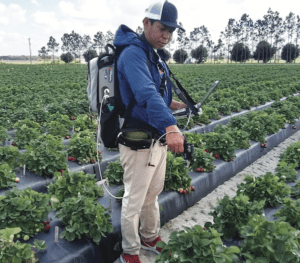Jul 8, 2022Powdery mildew detector gives strawberry growers tool to fight disease
New tools developed by researchers at the University of Florida (UF) will help them – and ultimately the industry – fight powdery mildew, one of the biggest diseases berry growers battle.
Scientists at UF’s Gulf Coast Research and Education Center (GCREC) in Balm say the new method to fight the disease could help strawberry growers globally.
The technology marries genomic data – all of an organism’s DNA – with phenomics, the study of plant growth, performance and composition. Through phenomics, scientists use DNA to measure plant traits.
Researchers already possess a wealth of technology that helps them understand strawberry genes. Those genes, however, need to be connected to their actual effect on the plant, in this case, how the plant resists powdery mildew disease. That’s why they combined genomics and phenomics, said Vance Whitaker, UF associate professor of horticulture at the GCREC.


“The main benefit to growers and the industry will be through breeding,” Whitaker said. “This is more of the type of technology breeders can use as a tool to breed better. Ultimately, all the knowledge we gain helps us to develop some kind of tool or technology we can use in breeding, whether a method like that or to discover a gene behind a resistance or some other trait.
“The impact to the industry will be by hopefully giving breeders tools that improve their breeding programs. All that has a clear application for us.”
In a GCREC field trial, Whitaker and his colleagues extracted DNA from each strawberry and reviewed the fruit’s genes. The scientists rated the severity of the disease via two methods: with their eyes, a traditional method using a visual scale, and using technology involving a sensor. The handheld sensor detected light wavelengths unseen by eyes. The wavelengths provided researchers data about the health and disease status of strawberry plants.
The technology helps better detect – and improve – powdery mildew resistance in new cultivars, Whitaker said.
“We showed that by combining the DNA information (genomics) and the spectroscopy information (phenomics), we can predict the visual rating of disease resistance surprisingly well,” he said.
In the future, researchers can discontinue or lessen the laborious practice of rating berries visually. The cost of obtaining DNA points about the berries’ DNA structure costs much less than manually seeking data points in the field, saving researchers time and money while providing more accurate detection, Whitaker said.
“DNA sequencing in a lot of cases is actually cheaper for us to do these days than sending someone into the field to measure something,” he said.
Over time, advances in technology decrease the price, similar to how the cost of computers have decreased even as technology improved.
“It’s an arrow like that in genome sequencing,” Whitaker said. “Compared to when I started 13 years ago, we can do things you couldn’t imagine doing then and can perform them cheaper than we could do even two years ago.”
Earlier studies showed the method detects diseases in other crops, said Whitaker, who is careful to warn that the new method isn’t guaranteed to work in every situation.
See more on strawberry production››
Mexican production during Florida’s traditional marketing window has made the U.S. strawberry deal more difficult. Helping to lower costs of protecting against diseases could benefit growers in leveling the playing field.
“As they grow a high-cost crop in an environment filled with risks, any problem we can reduce and help them better deal with, not only with trade, but with climate, disease, rising costs – all kinds of things – makes their lives a little less complicated and more successful,” Whitaker said.
“If we can produce a variety more resistant to powdery mildew and have them spend less controlling it, it’s an important benefit. Ultimately, the varieties will be a little easier to grow and perhaps present fewer risks to them.”
Ronald Tapia, a GCREC horticultural sciences doctoral student, led the research under supervision of Whitaker and Seonghee Lee, an assistant professor. Whitaker commended students’ efforts to make research solve real-life issues for growers.
– Doug Ohlemeier, assistant editor














